Download Pdf [2,32 MB] - MTU Aero Engines
Download Pdf [2,32 MB] - MTU Aero Engines
Download Pdf [2,32 MB] - MTU Aero Engines
Create successful ePaper yourself
Turn your PDF publications into a flip-book with our unique Google optimized e-Paper software.
Customers + Partners<br />
17,000 kilometers away from Auckland, the CF6-80C2 engines are supported by <strong>MTU</strong>’s maintenance facility in Hannover.<br />
The company realigned operations at a<br />
breakneck pace. When it introduced Boeing<br />
777-200ERs into service in November 2005,<br />
it significantly changed its long-haul course,<br />
with eight of the large twin jets today based<br />
at Auckland. The interior of the transports,<br />
too, saw some radical changes, the firstclass<br />
configuration being scrapped on long<br />
routes in favor of a new Business Premier<br />
setup in which the seats are configured in a<br />
herringbone layout. They extend into<br />
absolutely flat beds 2.07 meters long and<br />
compartmented by high vertical walls on<br />
either side. Also, the route network was<br />
cleared out, with unprofitable routes like that<br />
to Singapore being canceled and new promising<br />
destinations added, notably the new<br />
Shanghai route. Since October 2006, Air<br />
New Zealand has been flying around the<br />
world. In Europe, it traditionally serves only<br />
London Heathrow, flying to Auckland from<br />
there via Los Angeles. Of late, it also sends a<br />
jumbo jet every night from London to<br />
Auckland in the opposite direction, via Hong<br />
Kong, on a route that in flight time (21 to 24<br />
hours) and miles is almost exactly identical.<br />
The airline has been in business for over 60<br />
years, surviving times good and bad. On<br />
April 30, 1940, its predecessor company<br />
Tasman Empire Airways (TEAL) launched flying<br />
boat operations to Australia. In 1961,<br />
TEAL was taken over by the government and<br />
later renamed Air New Zealand, on April 1,<br />
1965. In October 1989 the company was privatized<br />
and its shares listed on the Auckland<br />
stock exchange. After its affiliate Ansett<br />
Australia went bust, the company in fiscal<br />
2000/2001 posted a loss of 612 million U.S.<br />
dollars, the largest ever incurred by a com-<br />
pany in New Zealand. The white knight then<br />
was the government, which took 80.2 percent<br />
of Air New Zealand’s stock and has<br />
been hanging on to it ever since. That<br />
marked the beginning of the airline’s rapid<br />
recovery. In 2002/2003, it already made<br />
close to 100 million U.S. dollars in profits. By<br />
now, under the leadership of its chief executive<br />
officer Rob Fyfe, Air New Zealand has de<br />
facto again become a serious factor in the<br />
industry. “We were very dynamic for an airline<br />
of our size with our strategic decisions in<br />
the last months,” is how Rob Fyfe sees it.<br />
The innovative Business Premier Class seats are<br />
driving Air New Zealand’s success.<br />
That also includes a decision, taken last year,<br />
to close its own engine maintenance operations<br />
in Auckland and outsource the engine<br />
MRO work. The company’s 34 General<br />
Electric CF6-80C2 engines, which power<br />
part of its Boeing 747-400s and 767-300ER<br />
fleet, plus spare engines, are now being<br />
maintained by <strong>MTU</strong> Maintenance Hannover<br />
some 17,000 kilometers away. Fyfe praises<br />
the effectiveness of the cooperative effort:<br />
“By outsourcing the work to <strong>MTU</strong> the cost of<br />
maintaining our engines was lowered by 30<br />
percent and the turnaround is 50 percent<br />
quicker now.”<br />
According to Fyfe, Air New Zealand Cargo<br />
hauls eight to ten engines a year to Germany<br />
in its Boeing cargo aircraft. “We would take<br />
about 120 days per engine, <strong>MTU</strong> does it in<br />
50 to 60 days,” says a pleased airline CEO.<br />
“That’s mostly due to smooth logistic organization,”<br />
explains Nils Fenske, who at <strong>MTU</strong><br />
Maintenance Hannover is the director sales,<br />
Australia and Pacific Rim. Also, according to<br />
Fenske, <strong>MTU</strong> is known for its flexibility in<br />
spare parts provisioning, which otherwise<br />
necessitates lead times of between one and<br />
six months when ordering new parts. <strong>MTU</strong><br />
further uses a so-called flowline principle to<br />
facilitate the teardown and reassembly of<br />
engines, which is a tough job considering<br />
engines contain some 30,000 individual<br />
items. Adds Fenske: “Since we’re repairing a<br />
lot of engine parts in our high-tech shops<br />
and buying relatively few new parts from outside<br />
sources, costs are bound to come down<br />
appreciably.” He continues to say: “With its<br />
well-known reliability and quality standard,<br />
Minor engine work, like here on a Boeing 767, is performed<br />
in Auckland.<br />
Air New Zealand is our key customer in the<br />
region.”<br />
Already, the airline is planning ahead: Air<br />
New Zealand is presently mulling the addition<br />
of 23 new routes, many of which cannot<br />
be served until 2010 and after, when the first<br />
of the eight ordered Boeing 787-9s will be<br />
delivered, for which the New Zealanders constitute<br />
the launch customer. Independently<br />
of that, Air New Zealand has largely achieved<br />
its current goal: “We want to be market<br />
leader on all routes we serve—and that is<br />
already the case everywhere with the exception<br />
of Hong Kong where Cathay Pacific still<br />
leads,” says a proud CEO.<br />
For additional information, contact<br />
Nils Fenske<br />
+49 511 7806-390<br />
This article is available online at:<br />
http://www.mtu.de/107ANZE<br />
22 REPORT REPORT 23


![Download Pdf [2,32 MB] - MTU Aero Engines](https://img.yumpu.com/11154939/12/500x640/download-pdf-232-mb-mtu-aero-engines.jpg)


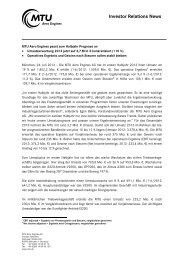
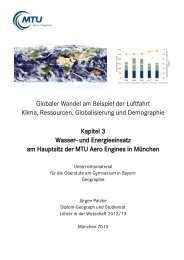
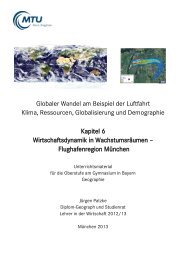
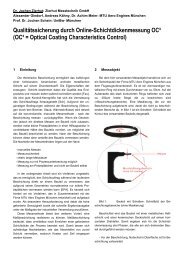
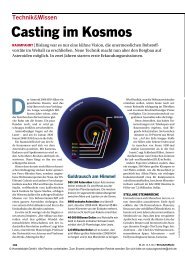

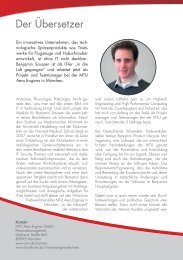
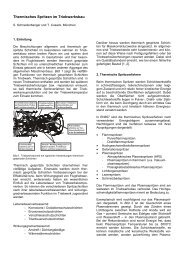
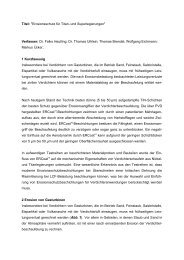


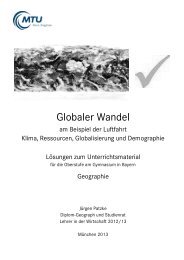
![Download PDF [5,37 MB] - MTU Aero Engines](https://img.yumpu.com/21945461/1/190x125/download-pdf-537-mb-mtu-aero-engines.jpg?quality=85)